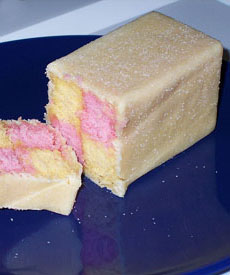Cake Glossary: A Glossary Of The Different Cake TypesCake Glossary A To B This is Page 1 of an 8-page article. Click on the red links below to visit other pages. This glossary is protected by copyright and cannot be reproduced in whole or part. You are welcome to link to it.
|
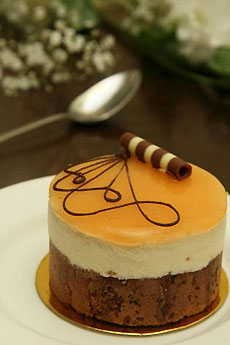 So many cakes, so little time. This delectable mousse cake with a caramel topping is from FinancierPastries.com. |
|
A Brief History Of Cakes The ancient Egyptians were the world’s first great bakers, with large-scale bakeries that produced unleavened breads and cakes, first baked on hot stones. They were the first to discover how to use wild (natural) yeast to make those flatbreads and cakes rise. Cakes are round because they descended from ancient breads—round loaves of dough placed on hearthstones to bake. Even though sugar originated in Asia, cakes as we now know them—flour, eggs, butter and sugar baked to a sweet, fluffy deliciousness—are a Western evolution. There are thousands of different types of cakes in the world today; each culture has its specialties, most of which never reach our shores. Here, we present some of the more popular types one is likely to encounter—or at least hear about—in the U.S.
It is important to note that there is no one—or even 100—recipes for any of the cakes described here. Over the centuries, bakers have varied and refined the original recipes to their own preferences, and the challenge for everyone who loves to bake (or eat) good cake is to keep trying recipes until we find the versions that suit us to perfection.
|
||
| ALMOND PASTE See marzipan.
|
||
| ANGEL FOOD CAKE A light, flourless cake made with sugar, cream of tartar, salt, vanilla or almond extract, and a dozen or so egg whites, depending on the recipe. There is no leavening. Angel cake is typically baked in a tube pan. It is popularly served with berries and whipped cream, although it is just fine plain or with a dessert sauce (caramel, chocolate, custard, fruit, etc.). Some historians think that the first angel food cakes were baked in the South by African-American slaves, due to the strength required to whip the air into the whites. Others theorize that the cake originated in Pennsylvania Dutch country in the early 1800s. October 10th is National Angel Food Cake Day. Here are recipes for a from-scratch angel food cake, and for a strawberry glaze. If you don’t want to bake from scratch, try a store-bought or cake mix. |
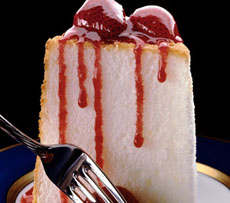 Light and airy angel food cake. Photo courtesy American Egg Board. |
|
| APPLESAUCE CAKE A cake made with raisins, walnuts, spices (cinnamon, cloves, nutmeg) and of course, applesauce. Some recipes add a square of baking chocolate. This casual cake cake makes a good snack cake unfrosted, or can be dressed up with a penuche (brown sugar) frosting. |
||
| BABA or BABA AU RHUM or RHUM BABA Small cakes baked in cylindrical molds, containing raisins or currants, made from yeast dough and soaked with sugar syrup, usually flavored with rum. According to legend, the baba evolved from the kouglhopf or kugelhopf. As the story goes, Polish King Stanislas Leszczynska (1710–1774), the the father-in-law of King Louis XV of France, was deposed and exiled to Lorraine, where he found the traditional kouglhopf too dry and dipped it in rum. His chef refined the recipe, using brioche dough and adding raisins. The king named the cake after one of the characters in his favorite book, Ali Baba; the name became shortened to baba. Not all babas are rhum babas; baba refers to the shape. Today, rhum babas are made a variety of shapes, including fluted (Bundt-like, as in the photo above), unfluted circle molds and individual, brioche-like portions. See also savarin.
|
 Baba. Photo by Julian Cenkier | SXC. |
|
| BABKA A yeast ring originating in Eastern European, baked with raisins or other dried fruit in the dough. Similar to coffee cake, without the glaze or streusel. Today it also is also made in a loaf shape. Some babkas, such as the one in the photo at right, are made in the style of a marble cake, swirled with chocolate, as a variation on the traditional dried fruit. |
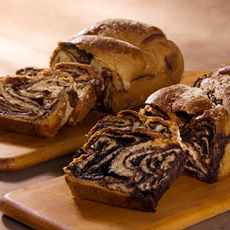 Babka available from Zabars.com. |
|
| BACCA DI MONTAGNA CAKE A lovely summer cake, the name means “berries from the mountain” or mountain berries. The white sponge cake layered with almond pastry cream is topped with wild blueberries and raspberries covered with a natural jelly glaze. The sides are pressed with almond biscotti crumbs. |
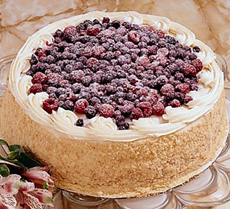 This Bacca di Montagna cake is available from 1-800-Bakery.com. |
|
| BAKED ALASKA This dessert is ice cream encased in meringue and browned in an oven. Though it did not get its current name until 1896, it was invented in 1804 by Benjamin Thompson Rumford (1753-1814), an American-born physicist who became a British subject during the American Revolution. The dessert was the by-product of his study of the resistance of stiffly beaten egg whites to the induction of heat. He named the dessert Omelette Surprise. Later versions added sponge cake underneath the ice cream, the recipe that is common today. |
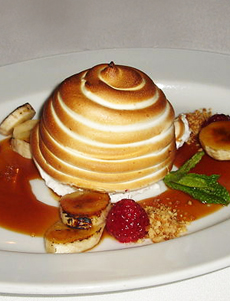 Baked Alaska. Photo of by Yun Huang Yong | Wikipedia. |
|
| BAKING The technique of cooking food in an enclosed space—it can be an oven, box, covered, dug pit, etc.—with dry heat. |
||
| BAKING POWDER A chemical leavening agent that causes batter to rise during the baking process. Baking powder consists of baking soda, cream of tartar (and/or sodium aluminum sulfate), plus cornstarch. It creates a chemical reaction that enlarges the air bubbles already present in the batter. |
||
| BAKING SODA Baking soda, another leavening agent, is also known as bicarbonate of soda and by its chemical name, sodium bicarbonate. It is about four times as strong as baking powder. Baking soda is used in recipes that contain an acidic ingredient: for example, brown sugar, buttermilk, chocolate, citrus juice, chocolate, fruit, honey, maple syrup, molasses, sour cream, vinegar and yogurt.
|
||
| BATTENBERG CAKE or WINDOW CAKE
A light sponge cake covered in marzipan with a checkerboard interior. One layer is dyed pink to contrast with the yellow cake; the layers are cut into uniform logs and joined with apricot jam into one cake. The origin of the name is obscure; one theory claims that the cake was created to celebrate the 1884 marriage of Queen Victoria’s granddaughter, Princess Alice, to Prince Louis of Battenberg. The four squares representing each of the four Battenberg princes: Louis, Alexander, Henry and Francis Joseph. Prince Louis of Battenberg is the father of Admiral of the Fleet Louis Mountbatten, 1st Earl Mountbatten of Burma, grandfather of Prince Philip, Duke of Edinburgh, consort of Queen Elizabeth II, and great-grandfather of Prince Charles.
|
||
| BATTER Batter is the uncooked material from which cakes are made. The main ingredients generally include flour, eggs, sugar, butter, flavoring (almond, chocolate, vanilla, etc.) and sometimes milk, cream or sour cream. These are the same ingredients as in a dough; the only difference is that a batter is thinner in consistency. The word comes from the French “battre,” meaning “to beat.”
|
Battenberg cake. Photo courtesy of Wikimedia.com. Below, a Rubik’s Cube Battenberg Cake. Photo courtesy Stasty.com. |
|
| BAUMKUCHEN Baumkuchen, German for "œtree cake," is an airy sponge painstakingly made of paper-thin layers so that it appears to be the cross-section of a tree. It is made by very few bakeries (five in the U.S.) since it requires special equipment and < face="Verdana,Arial,Times,New,I2">< size="2">time-consuming attention to detail. The cylinders in a specialty oven are< face="Verdana,Arial,Times,New,I2"> covered with batter. They rotate, bake, are recoated and baked again until 20 or more layers are created. The ovens can only make this one item, and baking requires constant attention (as opposed to leaving the cake for 40 minutes or so, then checking on it). It takes several hours per batch. Here’s a recipe you can make at home with a jerry-rigged toaster oven.
|
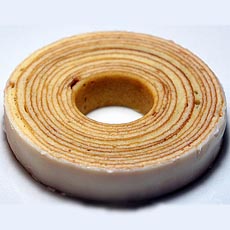 Baumkuchen, "œtree cake." Photo courtesy WaynesThisAndThat.com. |
|
| BEE STING CAKE or BIENENDTICH A German yeast cake filled with custard or pastry cream and frosted with honey, butter and almonds. It is more of a brioche pastry than an American-style cake. According to legend, it is named for a baker who made a cake with a honey topping, which attracted a bee that stung him. Here’s a recipe with step-by-step photos.
|
 A bee sting cake, made with honey. Photo © A Feast For The Eyes | AskChefDennis.com. |
|
| BIRTHDAY CAKE This generally refers to a frosted layer cake, decorated with roses or other themes that honor the interests of the celebrant. It typically has the inscription,“Happy Birthday” and the celebrant’s name. Tradition is to include one candle for each year—up to a certain point, when discretion and the surface area of the cake recommend only one or a few candles. The custom may have begun in ancient Greece with honey cakes. Ancient Romans also celebrated their 50th year with a honey cake. Much later, cakes celebrated birthdays of young children in Germany. In medieval England, coins were mixed into the batter and the tradition continues there today. From early times, fire sent signals to the gods; today, one makes a private wish while blowing out the candles on one’s cake.
|
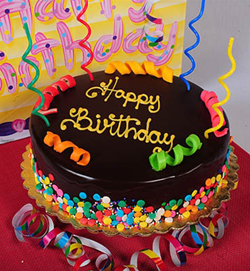 While some birthday cakes are even greater works of art than wedding cakes—sculptures that one wouldn’t dare mar with candles—the iconic birthday cake often just has a few buttercream roses. The cake above can be ordered from ChocolateBakery.com. |
|
| BLACK BOTTOM CAKE A cake fashioned after the black bottom pie, which has a chocolate layer bottom and a vanilla pudding top. In the cake version, a chocolate layer is topped with a cream cheese/chocolate chip layer, which bakes into a cheesecake-like top.
|
||
| BLACK FOREST CAKE A chocolate layer cake, filled with Kirsch-flavored whipped cream and sour Morello cherries and traditionally frosted with whipped cream and chocolate curls. The cake is believed to have originated in the late 16th century in the Black Forest region of Germany. The area is known for its sour Morello cherries and Kirschwasser, a clear brandy made from the cherries. Read more about the history of the Black Forest Cake, including a recipe. |
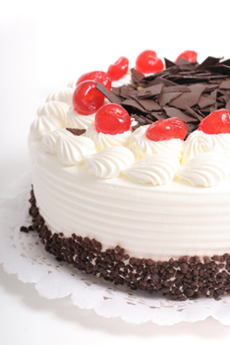 Black Forest Cake. Photo by Oksana Struk | IST. |
|
| BLACKOUT CAKE A blackout cake is a very dark chocolate layer cake, filled and frosted with dark chocolate pudding and covered in chocolate crumbs. It was developed in New York during World War II, named after the blackout drills performed by the Civilian Defense Corps. When the Navy sent ships to sea from the Brooklyn Navy Yard at night, the streetlights were turned off and the windows of Brooklyn were “blacked out” to avoid silhouetting the battleships against the city. |
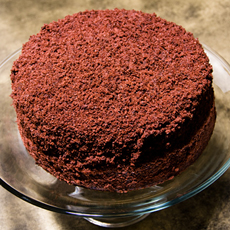 Blackout cake available at Zabars.com. |
|
| BLONDIE or BLONDE BROWNIE or BUTTERSCOTCH BROWNIE
According to The Oxford Encyclopedia of Food and Drink in America, by the 1950s, butterscotch or vanilla brownies were described as “blonde brownies.” Blondies are a “blonde” or golden bar cookie, the result of adding brown sugar to a vanilla dough base. The brown sugar plus butter creates the butterscotch flavor. While brownies can be cakey or fudgy style, blondies are always cake-style. They lack the chocolate that provides fudginess and require leaveners to achieve their cake texture (not required by fudgy-style chocolate brownies). Blondies can include chocolate chips or chopped nuts; butterscotch chips, peanut butter chips and toffee bits are also popular additions, When shredded coconut is added to the batter, the blondie becomes a Congo bar. Here’s a delicious recipe and the history of the blondie. |
 A blondie sprinkled with sanding sugar from Mari’s New York Brownies, a NIBBLE Top Pick Of The Week. Photo by Emily Chang | THE NIBBLE. |
|
| BOMBE A bombe, also known as a dome, is a dome-shaped confection made of cake and mousse (or other creamy center). The word comes from the French bombé, meaning domed or rounded. Created in a dome- or melon-shaped mold, two or more fillings are layered, typically atop a layer of cake. When unmolded, they can be covered with a thin layer of chocolate, with meringue or other tasty topping. Frozen bombes are combinations of ice cream and sorbet, sometimes with cake (a dome-shaped Baked Alaska is a bombe). When the bomb is cut, the interior should present a contrast of colors and textures. While the chocolate bombe in the photo, with flourless chocolate cake and halvah mousse, is not flashy, frozen bombes especially can look like a tropical paradise (strawberry ice cream with mango and kiwi sorbet, for example).
|
 Chocolate bombe. Photo courtesy TatteCookies.com. |
|
| BOSTON CREAM PIE Just as the cheesecake is really a pie, the Boston Cream Pie is really a cake: two layers of sponge cake filled with vanilla custard and glazed with chocolate. It is the descendant of the early American pudding-cake pie. The first reference, a recipe published in 1855, calls it a “pudding pie cake” and had a powdered sugar topping, which evolved to the current chocolate glaze. So why is it called a pie? The answer is most likely that, in the mid-19th century pie tins were more common than cake pans. The distinction between calling something pie or cake was more flexible than it is today. The cake might well have been baked in pie tins. Chef M. Sanzian, hired for the opening of Boston’s Parker House Hotel in 1856, is credited with the modern Boston Cream Pie, a sophisticated remake of the early American pudding-cake pie recipe. He sandwiched two layers of sponge cake with crème pâtissière, a vanilla-flavored custard. He topped the cake with a chocolate ganache glaze. At the Parker House Hotel, the cake was originally served with the names Chocolate Cream Pie or Parker House Chocolate Cream Pie. Beginning in the 20th century, a custard filling often replaced the crème pâtissière. In 1996, Boston Cream Pie was declared the official cake of Massachusetts. In modern times, a custard filling often replaces the crème pâtissière. October 23 is National Boston Cream Pie Day. Make one with this recipe.
|
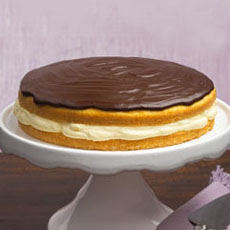 Boston cream pie; here’s the recipe. Photo courtesy KraftRecipes.com. |
|
| BOUCHON A small, bite-size chocolate cake with brownie-like qualities. Bouchon is the French word for cork, and the cakes are baked in tin that produces cork shapes. Since French recipes tend to be on the bittersweet rather than the sugary side, they go well with a demi-sec or Pinot Noir-based Champagne—all the more reason to celebrate! They are a signature pastry at Thomas Keller’s Bouchon Bakery, where mini chocolate chips are baked into the batter (photo at right) and the tops are dusted with confectioner’s sugar. |
 Bouchons. Photo courtesy Bouchon Bakery. |
|
| BREAD There is a transition between sweet breads and low-sugar cakes baked in loaf pans, such as carrot bread and banana bread. What’s the difference between a banana bread and a banana cake? The obvious difference is that banana bread (or other bread) is baked in a loaf pan while a cake is baked in a round, square or rectangular cake pan. A less obvious distinction is that the bread style of cake, as a quickbread*, is leavened with baking soda. In general, loaf cakes or “breads” also have a denser crumb, a rougher texture and often less sugar than their cake counterparts. While the origin of the “bread” style of cake is unknown, food historians believe that it was originated in the 18th century with housewives experimenting with pearl ash. Banana bread became common in American cookbooks in the 1930s, with the popularization of baking soda and baking powder, and very popular in the 1960s, when variations with simple inclusions (nuts, chocolate morsels) created simple but delicious snack cakes. *Quickbreads use a chemical leavener instead of yeast, which makes them quick to rise. Other examples include cornbread, biscuits, muffins, scones soda bread. |
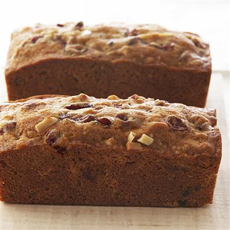 Photo of cranberry nut bread courtesy of McCormick. This recipe and others available at McCormick.com. |
|
| BROWN BETTY Most often found in recipes for a Brown Betty or an Apple Brown Betty, a betty is like a pie without the crust. Sugared fruit is topped with buttered breadcrumbs and baked. The dish and name date back to Colonial times, but the original “Betty” is lost to history; the brown presumably refers to the browning of the fruit, as there is no brown sugar. See also crisp.
|
||
| BROWNIES & BARS While cake-like brownies and bars (like lemon bars) are baked in cake pans and have a dense, cakey texture, they are actually classified as bar cookies, not cakes. See the different types of cookies, and read the origin of brownies. |
 Brownies available from MackenzieLtd.com. |
|
| BÛCHE DE NOËL French for “yule log” or “Christmas Log.” Instead of gathering around the Christmas tree, French families gather around a Yule log burning in the fireplace. Sometime after 1870, a Parisian pâtissier was inspired by the festivity to create the first bûche de Noël, a chocolate frosted roulade, baked in a jelly roll pan. To imitate the log, a roll of génoise (sponge cake) is covered in chocolate buttercream that is textured to resemble bark. Smaller pieces of cake, also covered in buttercream, are affixed to the main roll to represent trimmed branches. The ends of the roll and the cut faces of the branches are frosted with vanilla cream to imitate cut wood. The log is decorated with holly leaves made of icing or marzipan, and meringue mushrooms. Fresh berries and powdered sugar (to resemble snow) can also be used. Today’s modern pâtissier make futuristic logs, with angular shapes, decorated in silver, like this one by Maison Kayser, enrobed in white chocolate with white chocolate slabs on the ends.
|
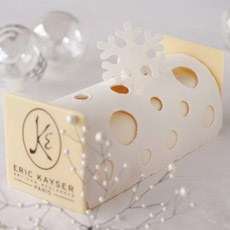  A classic Yule log design, available from MackenzieLtd.com. A more modern approach is below: a recipe from Pom Wonderful.  |
|
| BUNDT CAKE The Bundt cake was born in 1950, after the Bundt pan was created by H. David Dahlquist, the founder of Nordic Ware, a Minneapolis-based manufacturer of kitchenware products. He did so at the request of members of the Minneapolis chapter of Hadassah, a Jewish women’s service organization, based on a fluted ceramic kugelhopf cake mold from Europe that belonged to the mother of one of the members. The original kugelhopf, a Viennese specialty, is a sweet yeast bread similar to brioche and panettone. Over the years, denser cakes were baked in the same fluted molds. Dahlquist modified the design by introducing folds in the fluted edges, and fashioned the pan out of aluminum. According to the company, the name Bundt was taken from the German word bund, which means “community” or “a gathering of people”; Dahlquist added the “t” and trademarked the word. Read more about kugelhopf and the history of the bundt cake.
|
 Photo of King’s Cupboard White Hazelnut Cake Mix, baked in a Bundt pan. |
|
| BUTTER CAKE A butter cake is a cake made with shortening—butter, margarine, oil or vegetable shortening. They are finer-grained than fluffy sponge cakes, and thus are easier to make into white, yellow and chocolate layer cakes and loaf cakes. The American butter cake evolved from the English pound cake. In addition to butter, eggs, sugar and flour, they use a chemical leavener (baking powder or baking soda) to rise. Examples include coconut cake, cream cake, pound cake and queen cake. |
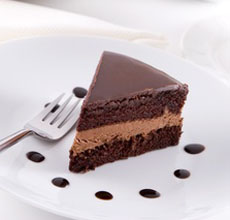 Chocolate cake. Photo © Olga Lyubkina | Fotolia. |
|
| BUTTERCREAM A frosting and filling made of unsalted butter, either egg yolks or egg whites, sugar and flavorings. There are many recipes for versions both cooked and uncooked. Buttercream can be variously flavored, including chocolate, coffee, lemon, lime, nut (e.g. pistachio), orange, peppermint, strawberry and vanilla. Go To Next Page: Terms With C Go To The Article Index Above
|
 Strawberry buttercream frosting. Photo courtesy SaintCupcake.com. |
|
Last Updated Apr 2018
© Copyright 2005-2025 Lifestyle Direct, Inc. All rights reserved. All images are copyrighted to their respective owners.
